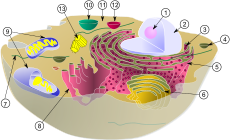
Back جسيم مركزي Arabic Центрозома Bulgarian সেন্ট্রোজোম Bengali/Bangla Centrozom BS Centrosoma Catalan Centrozom Czech Zentrosom German Κεντροσωμάτιο Greek Centrosome English Centrosoma Spanish

(1) nucleolus
(2) nucleus
(3) ribosomes (little dots)
(4) vesicle
(5) rough endoplasmic reticulum (RER)
(6) Golgi apparatus
(7) Cytoskeleton
(8) smooth endoplasmic reticulum(SER)
(9) mitochondria
(10) vacuole
(11) cytoplasm
(12) lysosome
(13) centrioles within centrosome
In cell biology, the centrosome is an organelle that is the main place where cell microtubules are organized. Also, it regulates the cell division cycle, the stages which lead up to one cell dividing in two.
The centrosome was discovered by Edouard Van Beneden in 1883,[1] and was described and named in 1888 by Theodor Boveri.[2]
The centrosome has apparently only evolved in animal cells.[3] Fungi and plants use other structures to organize their microtubules.[4] Although the centrosome has a key role in efficient mitosis in animal cells, it is not necessary.[5]
A centrosome is composed of two centrioles at right angles to each another. They are surrounded by a shapeless mass of protein.
- ↑ Wunderlich V. 2002. JMM - past and present. Journal of Molecular Medicine 80 (9): 545–548. doi:10.1007/s00109-002-0374-y. PMID 12226736.
- ↑ Boveri, Theodor (1888). Zellen-Studien II: Die Befruchtung und Teilung des Eies von Ascaris megalocephala. Jena: Gustav Fischer Verlag.
- ↑ Bornens M.; Azimzadeh J. 2007. Origin and Evolution of the Centrosome. Advances in experimental medicine and biology 607: 119–129. doi:10.1007/978-0-387-74021-8_10. PMID 17977464.
- ↑ Schmit 2002. Acentrosomal microtubule nucleation in higher plants. International Review of Cytology 220: 257–89. doi:10.1016/S0074-7696(02)20008-X. PMID 12224551.
- ↑ Mahoney N.M.; Goshima G.; Douglass A.D.; Vale R.D. 2006. Making microtubules and mitotic spindles in cells without functional centrosomes. Current Biology 16 (6): 564–569. doi:10.1016/j.cub.2006.01.053. PMID 16546079.